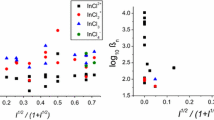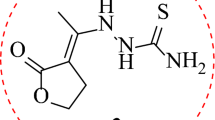Abstract
A new method has been devised to enable the determination of halide anions by isotachophoresis. This method uses an electrolyte system that employs indium(III) as a counter-ion to manipulate the effective mobilities of sample species by means of complexation reactions. This new procedure successfully enabled the simultaneous determination of the halide ions chloride, bromide, and iodide when a 12 mmol L−1 nitrate-based leading electrolyte containing 3.5 mmol L−1 indium(III) at pH 3.0 was used.



Similar content being viewed by others
References
Meissner T, Eisenbeiss F, Jastorff B (1999) J Chromatogr A 838:81–88
Lide DR (ed) (1993) CRC handbook of chemistry and physics. Chemical Rubber Publishing Co., Boca Raton
Boček P, Miedziak I, Deml M, Janák J (1977) J Chromatogr 137:83–91
Fukushi K, Hiiro K (1990) J Chromatogr 518:189–198
Madajová V, Turcelová E, Kaniansky D (1992) J Chromatogr 589:329–332
Fukushi K, Hiiro K (1997) J Chromatogr A 760:253–258
Gangolli S (ed) (1999) The dictionary of substances and their effects. Royal Society of Chemistry, Cambridge, UK
Beckers JL, Everaerts FM (1970) J Chromatogr 51:339–342
Hirokawa T, Tsuyoshi T, Kiso Y (1987) J Chromatogr 408:27–41
Prest JE, Baldock SJ, Fielden PR, Goddard NJ, Treves Brown BJ (2003) Anal Bioanal Chem 376:78–84
Prest JE, Baldock SJ, Fielden PR, Goddard NJ, Kalimeri K, Treves Brown BJ, Zgraggen M (2004) J Chromatogr A 1047:289–298
Tuck DG (1983) Pure Appl Chem 55:1477–1528
Dean JA (ed) (1999) Lange’s handbook of chemistry. McGraw–Hill, London
Prest JE, Baldock SJ, Fielden PR, Goddard NJ, Treves Brown BJ (2003) Analyst 128:1131–1136
Acknowledgements
The authors would like to thank the United Kingdom Home Office for funding this research programme and the Forensic Explosives Laboratory, of the Defence Science and Technology Laboratory, Fort Halstead, for their support.
Author information
Authors and Affiliations
Corresponding author
Rights and permissions
About this article
Cite this article
Prest, J.E., Fielden, P.R. The use of indium(III) as a complexing counter-ion to enable the separation of chloride, bromide, and iodide using isotachophoresis. Anal Bioanal Chem 382, 1339–1342 (2005). https://doi.org/10.1007/s00216-005-3267-4
Received:
Revised:
Accepted:
Published:
Issue Date:
DOI: https://doi.org/10.1007/s00216-005-3267-4




